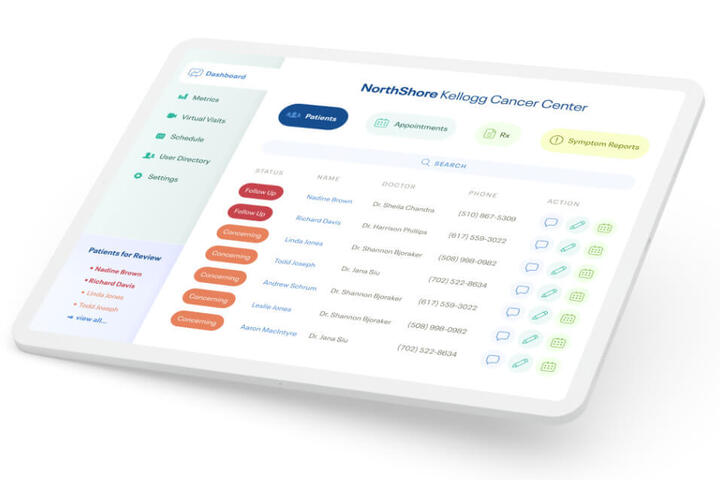Built With MongoDB: Memora Health

Always interested in healthcare, college roommates Manav Sevak and Kunaal Naik spent quite a bit of time exploring the various challenges that exist in the area of patient communication and discovered a common problem: patients often experience a profound sense of confusion about their care after they leave the hospital, along with a great sense of isolation.
Navigating complex medication regimens, instructions, dietary restrictions, and doctor’s orders without strong support tools was often impossible for patients, resulting in billions of dollars in preventable healthcare expenditures every year. Joining forces with Nisarg Patel, the roommates set out on a mission to rewire America’s healthcare systems with modern technology so that clinicians could interact meaningfully with their patients and patients could access healthcare information as easily as they could text their families and friends.
Three years later, the team has built a comprehensive platform that facilitates how care is delivered outside the four walls of the clinic. The trio joined Y Combinator’s winter 2018 cohort and has grown significantly since. Their company, Memora Health, has now raised $10.5 million from leading investors, including Andreessen Horowitz, and is used by more than 50 healthcare organizations across the country.
In this edition of #BuiltWithMongoDB, we talked with Memora Co-founder and CTO Kunaal Naik about building a healthcare technology business with MongoDB from day one.
MongoDB: You've said that you got into health tech to make an impact in an industry that is lagging in its use of technology. What solutions does Memora currently provide?
Kunaal: The healthcare industry is seriously lacking in its adoption of technology that can really improve how care is delivered. Although this may seem like a simple problem to solve on the surface, our team has really discovered the nuance that goes into making sure we are building tools that truly empower doctors and are easy to use for patients.
Memora provides a full suite of modules that simplify how patients and doctors interact. This ranges from remote monitoring and messaging programs that automatically track a patient’s health status to tools that automatically document notes in a patient’s medical record for clinicians to easily identify which patients may need additional care.
We’ve deployed our platform for several hundreds of thousands of patients and more than 50 healthcare organizations across the United States and Canada.
MongoDB: how has COVID impacted the adoption of new health tech solutions?
Kunaal: The pandemic has really accelerated how quickly large healthcare organizations — from health systems to insurers to life science companies — are adopting and implementing Memora. For the first time, it seems as if these organizations are realizing the need for large-scale change in how they reach and care for their patients. We are seeing significant adoption of the platform, which in turn has only given us more insight into how we can continue growing the platform to power more core functionalities inside of health systems.
An example of this is a situation where hospitals needed to build virtual waiting rooms to properly enforce social distancing and safety over the last year. Memora’s core workflow technology was used to build text-based screenings that allow patients to be screened for health concerns prior to a visit, assess acuity to determine if a visit can be conducted virtually, and enable patients to wait in their cars and automatically get notified when their doctor is ready to see them. We’re seeing that these kinds of digital workflows are actually easier for patients and clinicians and will likely be used even after the end of the pandemic. The core design of our platform has enabled us to support a broad spectrum of care delivery use cases like this, rather than just being a point solution.

MongoDB: What's your vision for the product?
Kunaal: Memora is a product-driven company, so the technical decisions we make significantly impact our ability to differentiate ourselves and provide a truly intelligent, scalable platform.
At scale, Memora is building an operating system for a new kind of care delivery — a platform that intelligently digitizes existing physician workflows and provides the entire infrastructure for how clinicians reach their patients and patients are cared for outside the four walls of the hospital. The infrastructure layer we are building for healthcare organizations will power everything from messaging to symptom management to remote monitoring to reimbursement. The platform is always learning — each encounter and physician workflow makes us smarter and allows us to deliver a higher standard of care to patients.
Over time, we want to increase Memora’s predictive capabilities. We have built a robust metrics infrastructure that intelligently adjusts message timing, frequency, escalations, and more for both doctors and patients.
Our integration with MongoDB has really helped scale all of these solutions, especially given how intensive they are from a data and computation perspective.
MongoDB: What does your tech stack consist of?
Kunaal: The core of our platform runs on JavaScript, and we use React Redux with TypeScript on the front end. On the back end, we’re using Node.js hosted on Google Cloud (Kubernetes). That’s plugged into MongoDB.
In terms of ease of use and scalability, Node.js works very easily with Kubernetes. MongoDB has been instrumental at powering data storage in a way that is scalable and HIPAA-compliant.
Our natural language processing engine is primarily written in Python, which has enabled us to implement a series of microservices.
MongoDB: Why did you choose to build with MongoDB?
Kunaal: When we were launching the core platform, we found the compatibility between Node.js and MongoDB to be very easy to use. This is in contrast to some SQL databases where you have to already be deeply knowledgeable about tables and indexing before you can get started. For our engineering team, this simplifies our onboarding process as well and allowing our engineers to work across the entire stack pretty quickly.
As adoption of our platform started to scale, we made a conscious decision to stick with MongoDB. From supporting indexing and joins, to simple replication management, to comprehensive and prebuilt backup infrastructure, MongoDB truly offers a set of services that make it easy for early-stage companies to get started but also scale. Our team has constantly mentioned how simple the MongoDB schemas are to quickly learn — and we’ve been able to get technical advice from consulting engineers such as MongoDB’s Abhinav Duggal when we need it.
Because we operate in a highly regulated industry, MongoDB’s business practices related to providing Backend as a Service (BaaS) and service-level agreement (SLAs) are additionally compelling to make sure we can meet the security requirements of our customers.
Looking to build something cool? Get started with the MongoDB for Startups program.